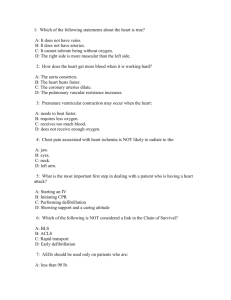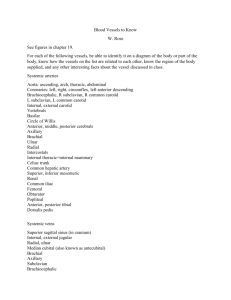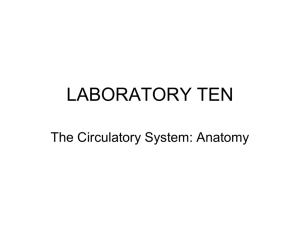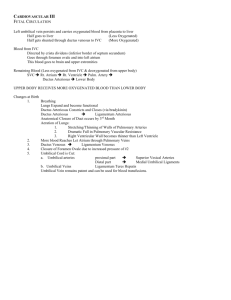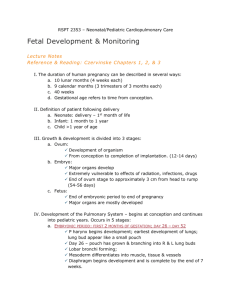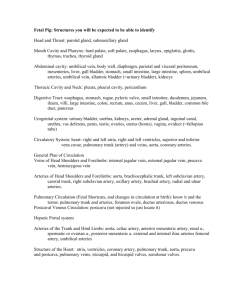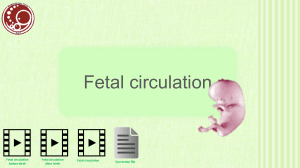TOPIC REVIEW SHEET
advertisement
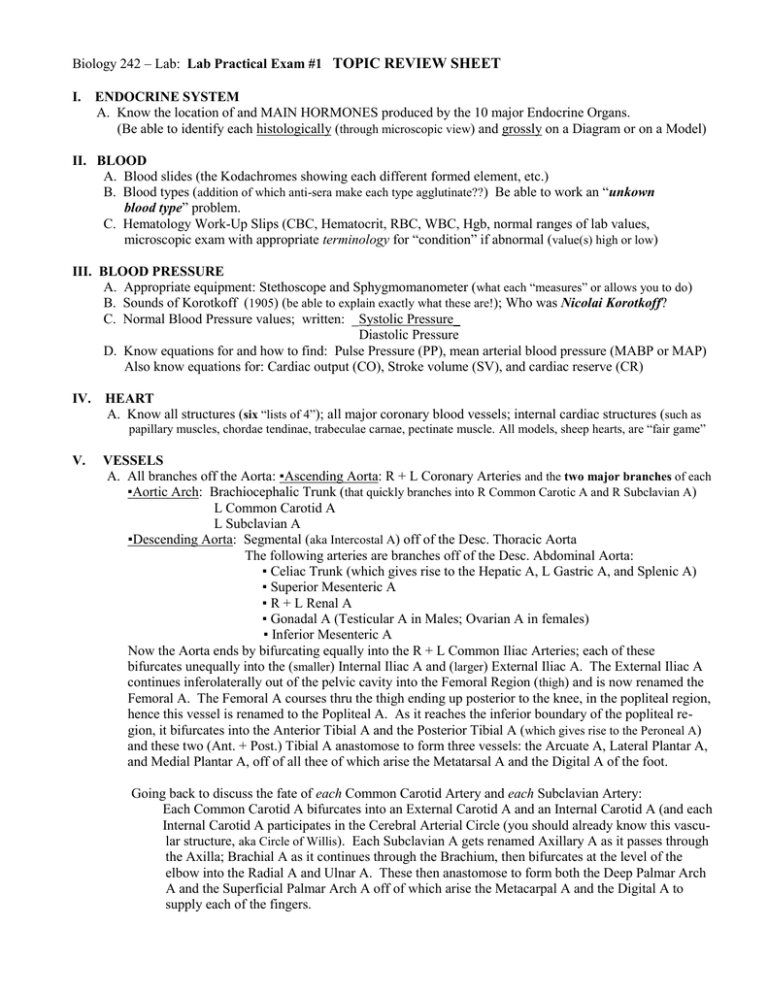
Biology 242 – Lab: Lab Practical Exam #1 TOPIC REVIEW SHEET I. ENDOCRINE SYSTEM A. Know the location of and MAIN HORMONES produced by the 10 major Endocrine Organs. (Be able to identify each histologically (through microscopic view) and grossly on a Diagram or on a Model) II. BLOOD A. Blood slides (the Kodachromes showing each different formed element, etc.) B. Blood types (addition of which anti-sera make each type agglutinate??) Be able to work an “unkown blood type” problem. C. Hematology Work-Up Slips (CBC, Hematocrit, RBC, WBC, Hgb, normal ranges of lab values, microscopic exam with appropriate terminology for “condition” if abnormal (value(s) high or low) III. BLOOD PRESSURE A. Appropriate equipment: Stethoscope and Sphygmomanometer (what each “measures” or allows you to do) B. Sounds of Korotkoff (1905) (be able to explain exactly what these are!); Who was Nicolai Korotkoff? C. Normal Blood Pressure values; written: _Systolic Pressure_ Diastolic Pressure D. Know equations for and how to find: Pulse Pressure (PP), mean arterial blood pressure (MABP or MAP) Also know equations for: Cardiac output (CO), Stroke volume (SV), and cardiac reserve (CR) IV. HEART A. Know all structures (six “lists of 4”); all major coronary blood vessels; internal cardiac structures (such as papillary muscles, chordae tendinae, trabeculae carnae, pectinate muscle. All models, sheep hearts, are “fair game” V. VESSELS A. All branches off the Aorta: ▪Ascending Aorta: R + L Coronary Arteries and the two major branches of each ▪Aortic Arch: Brachiocephalic Trunk (that quickly branches into R Common Carotic A and R Subclavian A) L Common Carotid A L Subclavian A ▪Descending Aorta: Segmental (aka Intercostal A) off of the Desc. Thoracic Aorta The following arteries are branches off of the Desc. Abdominal Aorta: ▪ Celiac Trunk (which gives rise to the Hepatic A, L Gastric A, and Splenic A) ▪ Superior Mesenteric A ▪ R + L Renal A ▪ Gonadal A (Testicular A in Males; Ovarian A in females) ▪ Inferior Mesenteric A Now the Aorta ends by bifurcating equally into the R + L Common Iliac Arteries; each of these bifurcates unequally into the (smaller) Internal Iliac A and (larger) External Iliac A. The External Iliac A continues inferolaterally out of the pelvic cavity into the Femoral Region (thigh) and is now renamed the Femoral A. The Femoral A courses thru the thigh ending up posterior to the knee, in the popliteal region, hence this vessel is renamed to the Popliteal A. As it reaches the inferior boundary of the popliteal region, it bifurcates into the Anterior Tibial A and the Posterior Tibial A (which gives rise to the Peroneal A) and these two (Ant. + Post.) Tibial A anastomose to form three vessels: the Arcuate A, Lateral Plantar A, and Medial Plantar A, off of all thee of which arise the Metatarsal A and the Digital A of the foot. Going back to discuss the fate of each Common Carotid Artery and each Subclavian Artery: Each Common Carotid A bifurcates into an External Carotid A and an Internal Carotid A (and each Internal Carotid A participates in the Cerebral Arterial Circle (you should already know this vascular structure, aka Circle of Willis). Each Subclavian A gets renamed Axillary A as it passes through the Axilla; Brachial A as it continues through the Brachium, then bifurcates at the level of the elbow into the Radial A and Ulnar A. These then anastomose to form both the Deep Palmar Arch A and the Superficial Palmar Arch A off of which arise the Metacarpal A and the Digital A to supply each of the fingers. Biology 251- Lab: Lab Practical Exam #1 V. TOPIC REVIEW SHEET - continued Page Two VESSELS – continued B. The Veins you are responsible for are ALL the VEINS which run with the Arteries that have been listed above; plus the ▪ Hepatic Portal Venous System: SSPIG: Splenic V, Superior Mesenteric V, Pancreatic V, Inferior Mesenteric V, and Gastric V which all flow together at the porta hepatis to form the Hepatic Portal V ▪ Great Saphenous V; ▪ Azygous V (on the Right only); ▪Hemiazygous V (on the Left only); ▪ Internal Jugular Vein accompanies the Common Carotid A in the neck region (there is no such thing as a Carotid Vein. This is one of rare examples of the deep vein NOT bearing the same name as the artery with which it runs.) Remember, there is only ONE Brachiocephalic Trunk (an artery); but there are TWO Brachiocephalic Veins (each B/C Vein is formed by the confluens of the Internal Jugular V and Subclavian V on the respective side. The L B/C V is LONGER than the R B/C V because: given that these two B/C Veins merge to form the SVC which lies to the R of midline – so that it lines up with the Right Atrium of the Heart - the B/C V on the L has farther to travel (it has to cross the midline to get to the R of it!) C. Be sure to study “Artery Man” (Fig. 21.18 – Page 761 of Text) and “Vein Man” (Fig. 21.23 – Page 778); since there will be 5 blood vessels from each of those figures (shown as Transparencies) on the Practical Exam. VI. FETAL CIRCULATION A. On a diagram, or a model, (ie, Fig. 21.30, P.794 of text) be able to recognize: ▪ Placenta, ▪ Umbilical Vein (there is only 1 of these), ▪ Ductus Venosus, ▪ Foramen Ovale, ▪ Ductus Arteriosus, ▪▪ R + L Umbilical Arteries (there are 2 of these), and ▪ Umbilical cord. B. Know what each fetal structure “becomes” at (or shortly after) birth: ▪Ductus Venosus = Ligamentum venosum (a fibrous cord on inferior surface of liver) ▪Ductus Arteriosus = Ligamentum arteriosum (between the Pulmonary Trunk and the Aorta) ▪Umbilical Vein = Ligamentum teres (aka Round Ligament of the Liver) which attaches (anchors) the liver to the umbilicus; runs at the leading edge of the Falciform Ligament. ▪R + L Umbilical Arteries = Medial umbilical ligaments; fibrous cords. ▪Foramen Ovale = Fossa Ovalis; a grossly visible depression in the interatrial septum; visible from both the R Atrial side and the L Atrial side (more pronounced on the R, since the “flap” was on the L) ▪Placenta = “Afterbirth” ▪Umbilical cord = desirable as “research material” or for harvesting mesenchymal stem cells. C. Understand fetal blood flow from Placenta back to the Placenta in terms of through which structures the MAJORITY of blood passes. (MOST of the blood, on the first pass, is “shunted” from the right heart to the left heart via the Foramen Ovale….since NOT MUCH blood is needed by the developing lungs – they are not yet responsible for oxygenating the fetal blood. Of course, SOME blood is routed through Pulmonary Circulation: from the RA → Tricuspid Valve → RV → Pulmonary SL Valve → Pulm. Trunk → Pulm A → Lung and back to the fetal heart’s L side….but even of the blood that seeks this route, much is “hijacked” at the Ductus Ateriosus to be sent into fetal Systemic Circulation.)

